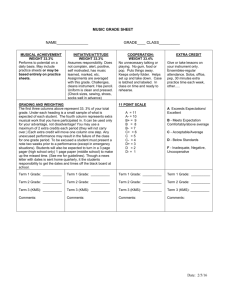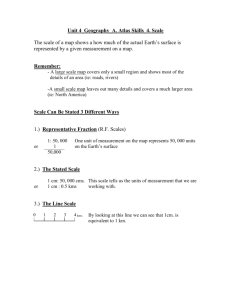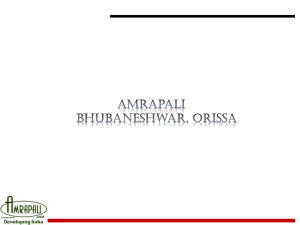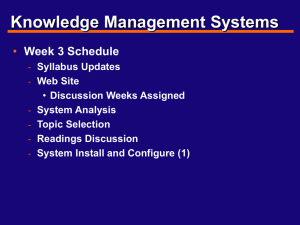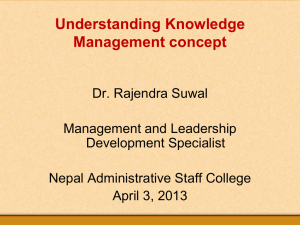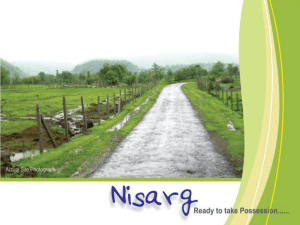Knowledge management practices in Indian Software
advertisement
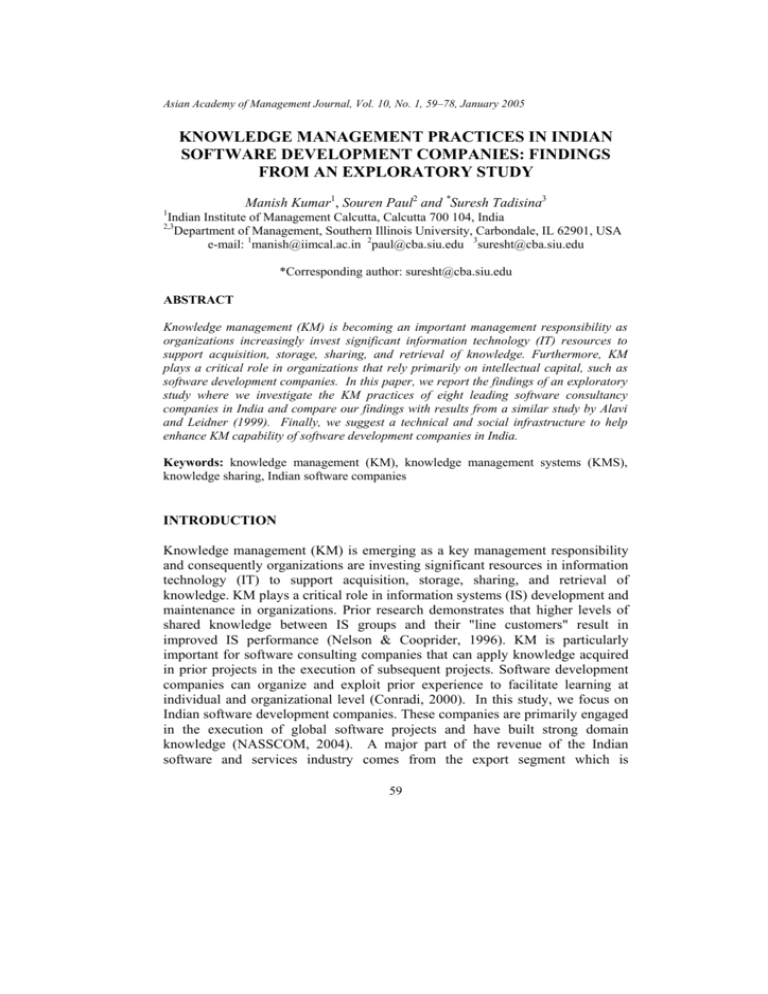
Asian Academy of Management Journal, Vol. 10, No. 1, 59–78, January 2005 KNOWLEDGE MANAGEMENT PRACTICES IN INDIAN SOFTWARE DEVELOPMENT COMPANIES: FINDINGS FROM AN EXPLORATORY STUDY Manish Kumar1, Souren Paul2 and *Suresh Tadisina3 1 Indian Institute of Management Calcutta, Calcutta 700 104, India Department of Management, Southern Illinois University, Carbondale, IL 62901, USA e-mail: 1manish@iimcal.ac.in 2paul@cba.siu.edu 3suresht@cba.siu.edu 2,3 *Corresponding author: suresht@cba.siu.edu ABSTRACT Knowledge management (KM) is becoming an important management responsibility as organizations increasingly invest significant information technology (IT) resources to support acquisition, storage, sharing, and retrieval of knowledge. Furthermore, KM plays a critical role in organizations that rely primarily on intellectual capital, such as software development companies. In this paper, we report the findings of an exploratory study where we investigate the KM practices of eight leading software consultancy companies in India and compare our findings with results from a similar study by Alavi and Leidner (1999). Finally, we suggest a technical and social infrastructure to help enhance KM capability of software development companies in India. Keywords: knowledge management (KM), knowledge management systems (KMS), knowledge sharing, Indian software companies INTRODUCTION Knowledge management (KM) is emerging as a key management responsibility and consequently organizations are investing significant resources in information technology (IT) to support acquisition, storage, sharing, and retrieval of knowledge. KM plays a critical role in information systems (IS) development and maintenance in organizations. Prior research demonstrates that higher levels of shared knowledge between IS groups and their "line customers" result in improved IS performance (Nelson & Cooprider, 1996). KM is particularly important for software consulting companies that can apply knowledge acquired in prior projects in the execution of subsequent projects. Software development companies can organize and exploit prior experience to facilitate learning at individual and organizational level (Conradi, 2000). In this study, we focus on Indian software development companies. These companies are primarily engaged in the execution of global software projects and have built strong domain knowledge (NASSCOM, 2004). A major part of the revenue of the Indian software and services industry comes from the export segment which is 59 Manish Kumar, Souren Paul and Suresh Tadisina registering strong annual growth of about 30% in recent years (NASSCOM, 2004). Growth in software development, especially in the export industry can be sustained by leveraging existing knowledge and effectively managing knowledge, at the organizational level. Despite having a plethora of published work on the Indian software industry, there is hardly any discussion on the KM practices of leading software development companies. We attempt to close this gap by embarking on an exploratory study on the KM practices of Indian software companies. The paper starts with a discussion of knowledge, KM, and knowledge management systems (KMS) and their relevance to software development companies. Next, we identify a set of research questions/issues and follow it up with a discussion of our research design and results. We compare our results with a similar study by Alavi and Leidner (1999) and conclude with a discussion of a technical and social infrastructure to help enhance KM capability of Indian software development companies. THEORETICAL BACKGROUND Knowledge, KM and KMS Alavi and Leidner (2001) view knowledge as personalized that is "related to facts, procedures, concepts, interpretations, ideas, observations, and judgements" (p. 109). They further posit that knowledge is the outcome of cognitive processing of information. Knowledge is also defined as the justified belief that increases an individual's or a group's capacity for effective action (Huber, 1991; Nonaka, 1994). Knowledge can be transferred from a source to a receiver. However, in order for effective knowledge transfer to take place, knowledge should be expressed in a form that is "interpretable by receivers" (Alavi & Leidner, 2001, p. 110). Two types of knowledge have been discussed in the literature – "tacit knowledge" and "explicit knowledge" (Nonaka, 1994). Tacit knowledge is derived from personal experience and reflects individual beliefs. Tacit knowledge of a particular context can have both cognitive (such as, mental model, beliefs, paradigms) and technical (such as, know-how and skills) dimensions (Nonaka, 1994; Alavi & Leidner, 2001). Explicit knowledge is formal codified knowledge that can be communicated to others. Knowledge can also be distinguished into individual and collective knowledge. Just as knowledge is created by individuals, a collection of individuals may interact and/or form alliances to generate collective knowledge (Nonaka, 1994). 60 Knowledge Management Practices Collective knowledge strengthens the ability of an organization and so that an organization can take actions that an individual is unable to take (Bennet & Bennet, 2003, p. 2). The term KM refers to a concerted effort by an organization to manage knowledge held within and outside the organization. Alavi and Leidner (2001) elaborate the definition of KM as a systemic and organizationally specified process for acquiring, organizing, and communicating both tacit and explicit knowledge of their employees so that others may make use of it to be more effective and productive. However, organizations cannot create knowledge without individuals (Nonaka, 1994). Organizational knowledge creation involves interaction among sources of knowledge so that knowledge may be shared and collective interpretations may be developed. Organizational knowledge creation has also been described in terms of four different modes of interaction between tacit and explicit knowledge (Nonaka, 1994). These are tacit-tacit knowledge conversion or socialization (e.g. on-the-job training); explicit-explicit knowledge conversion or combination (e.g. combining knowledge through meetings or conversations); tacit-explicit knowledge conversion or externalization (e.g. elicitation of stories); explicit-tacit knowledge conversion or internalization (e.g. reading documents from many sources) (Nonaka, 1994; Marwick, 2001). Various types of technologies (such as, electronic meetings, search tools, visualization technologies) may be used to develop KM systems that facilitate the knowledge conversion processes. KMS are "IT-based systems developed to support and enhance the organizational processes of knowledge creation, storage/retrieval, transfer, and application" (Alavi & Leidner, 2001, p. 114). Marwick (2001) discusses various types of IT that can be used to facilitate transformation of knowledge. For example, electronic meetings can support tacit-tacit knowledge transformation; browsable audio/video presentations can support explicit-tacit knowledge transformation; text search and document categorization technologies can support explicitexplicit knowledge transformation. A major role of KMS is to connect knowledge from different entities throughout the organization and ensure that individuals or groups are aware of the availability of the knowledge (Frappaolo & Capshaw, 1999). A variety of information technologies may be used in KMS to support different KM processes (Alavi & Leidner, 2001). Table 1 presents the potential role of IT in different phases of KM. These technologies are embodied in organizational KM platforms that can be supported by groupware and/or Intranets. 61 Manish Kumar, Souren Paul and Suresh Tadisina TABLE 1 ROLE OF IT IN DIFFERENT KM PROCESSES (ADAPTED FROM ALAVI & LEIDNER, 2001) KM process Knowledge creation Knowledge storage/ retrieval Knowledge transfer Enabling IT • Data mining • Learning tools • • • • Knowledge repositories Databases Datawarehouses Electronic bulletin boards • Electronic bulletin boards • Knowledge directories Role of IT • Discovering knowledge • Combining new sources of knowledge • Support individual and collective knowledge storage • Facilitate inter-group knowledge access • Extend knowledge network and communication channels • Easy access to knowledge sources KM in Software Development and Consulting Companies Consulting companies, such as McKinsey, KPMG Peat Marwick, Anderson Consulting, Ernst & Young, and PricewaterhouseCoopers are engaged in knowledge work. In order to improve the capability of the consultants and leverage expertise available in a part of the organization to benefit the whole organization, these companies employ various types of technologies to manage internal knowledge. For example, document repositories and best practices databases are used to manage visible knowledge and information resources, such as project reports, presentations to the client, information about best practices in various industries, market information, client information, etc. Knowledge held in the mind of individual employees of these organizations is invisible in nature and can only be shared with others through communities of practice, seminars, and electronic discussion boards. Broadly speaking, knowledge repository, best practices database, expert yellow pages and electronic discussion boards, help in storage, retrieval and sharing of knowledge and information through organizational groupware and Intranets. KM is critical for software consultancy firms engaged in execution of software projects as they rely significantly on intellectual capital. In the event of attrition of experienced manpower, sustaining a high level of competence is a major challenge to these organizations. Hence, these organizations rely on KM activities, such as document management, competence management, and software reuse to sustain the level of competence (Rus & Lindvall, 2002). In 62 Knowledge Management Practices order to enable learning from prior experience, these organizations encourage creation of collective memory, such as product and project memory. Software engineering practices, such as version control and requirement traceability enable the development of memories from the daily work of the employees in software organizations (Rus & Lindvall, 2002). The importance of KM and KMS in software organizations has been extensively discussed in the recent literature (Birk, Dingsoyr, & Stalhane, 2002; Schneider, Hunnius, & Basili, 2002; KomiSirvio, Mantyniemi, & Seppanen, 2002). Birk, Dingsoyr, and Stalhane (2002) discuss the problem of not reusing or sharing the knowledge gained during the execution of a project. Schneider, Hunnius, and Basili (2002) elucidate the challenges in setting up a "Software Experience Center" so that experience gained from previous software projects can be reused. Komi-Sirvio, Mantyniemi, and Seppanen (2002) discuss a KM approach that is more project-based and context specific in nature. Needless to mention, the issue of KM is of paramount importance for the software companies that are engaged in global software projects. These companies deal with clients who may have different cultural backgrounds and may follow different business practices. Ramasubramanian and Jagadeesan (2002) discuss the challenge of managing knowledge at Infosys, a leading software company in India that provides "consultancy and software services worldwide to Fortune 500 companies" (p. 53). They discuss how an incentive scheme was introduced to encourage the building and maintenance of central knowledge repositories that consist of documents and expertise maps. The use of the central repository resulted in increased productivity and reduced cost (through reduced defects). RESEARCH QUESTIONS In this paper, we intend to extend the prior research on KM in software development and consulting companies by focusing on leading software firms in India. As this is an exploratory study, we attempt to make a macro-level yet holistic assessment of the KM practices of Indian software companies by addressing the following research questions: • What are the dominant perspectives about KM in Indian software companies? • What are the most needed KM capabilities of these organizations? • What are the social interaction modes through which knowledge conversion takes place in these companies? • What are the important knowledge domains in these companies? • What are the technologies (IT) used to implement KMS in these companies? 63 Manish Kumar, Souren Paul and Suresh Tadisina • Which activities of the KM process have been supported by IT in these companies? • What are the specific and tangible benefits targeted as outcomes of KM initiatives in these companies? RESEARCH DESIGN In an attempt to gain insight into the KM practices in Indian software organizations, we studied leading software consulting companies in India. The Indian software industry is a US$15.9 billion (2003–2004 revenue) industry. Most of the revenue comes from software export (US$12.5 billion in 2003– 2004). The software companies in India are involved in making end user application software with a high degree of customization. In these types of software development projects, the software team should have knowledge about the user industry, business processes, and relevant technologies. In this exploratory study, we conducted semi-structured interviews of senior executives in eight software development companies in the years 2001–2002. The focus group included senior level executives (such as, partner, vice-president – projects, senior manager projects) who are either championing KM initiatives or supervising software development projects. We focused on eight leading software development companies in India. These companies are eight of the top 20 software development companies in India. Their revenue ranged from US$20 million to US$300 million in 2001–2002. The respondents included a chief executive officer (CEO), a partner, a vice-president, a head of a development center, an executive in-charge of KM practice, and senior managers in KM roles. The semi-structured interviews were based on a questionnaire that was adapted from Alavi and Leidner's (1999) work. We inquired about respondents' perspectives on KM; KM capabilities needed in their organizations; characteristics of KMS in their organizations; and perceived benefits of existing KMS. The data were collated and analyzed manually and the results are presented in the following section. RESULTS The responses were analyzed using simple statistical methods, such as frequencies. As the sample was small, we did not conduct any parametric or even non-parametric statistical test. The results of the data analyses are presented as per the sequence of the research questions/issues raised earlier. 64 Knowledge Management Practices KM Perspectives Respondents were asked about their understanding of the term KM. Three categories of perspectives were mentioned by the respondents: management of intellectual resources, improvement of capabilities of employees, and efficiency (see Figure 1). The respondents who view KM as management of intellectual resources focused primarily on management of expertise relating to technology and business processes. Management of competitor and customer information was also considered important. Improving capabilities of employees involves various ways of sharing knowledge with non-experts in organizations. The respondents who view KM in terms of improving efficiency seem to ascribe it to efforts to avoid repeating mistakes and reuse software components. Various KM perspectives of the respondents are summarized in Table 2. TABLE 2 PERSPECTIVES ON KNOWLEDGE MANAGEMENT Management of intellectual resources • Manage expertise related to technology • Managing expertise related to business process of the user organizations • Management of marketing, competitor and customer information • Know what we know and don't know Improving the capabilities of the employees • Harvesting knowledge, sharing knowledge • Communities of practice • Sharing knowledge with the employees • Writing expert articles for others to use • Share lessons learnt in execution of projects • Share do's and don'ts 65 Improving efficiency • Prevent repeating mistakes • Prevent reinvention of wheel • Reuse software components • Selling existing services to more customers Manish Kumar, Souren Paul and Suresh Tadisina 8 8 Frequency 7 6 6 5 5 4 3 2 1 0 Management of Improving the intellectual capabilities of resources the employees Improving efficiency Figure 1. KM perspectives Most Needed KM Capability Respondents had different perspectives on the KM capability most needed by their organizations. Most of them consider management of knowledge assets as the most needed KM capability. This includes abilities to support collection of knowledge, updating of knowledge base, and filtering items to maintain relevancy of knowledge assets. Respondents also consider that KM infrastructure and knowledge sharing culture are other needed capabilities of KM. In general, large organizations that have initiated KM activities referred to knowledge sharing culture and management of huge knowledge databases as their problem areas while the smaller organizations which are still developing KM infrastructure considered the infrastructure as most needed capability. Table 3 lists the different perspectives on most needed KM capabilities. Figure 2 shows the number of respondents supporting each perspective. 66 Knowledge Management Practices TABLE 3 PERSPECTIVES ON MOST NEEDED KM CAPABILITIES Management of knowledge assets • Responding and collecting knowledge documents • Keeping knowledge current in the database • Filtering of obsolete things • Focusing on selected areas of business and industry practices Knowledge sharing culture KM infrastructure • Understanding that time spent in mentoring and sharing will be as beneficial as other operations in the company • Organization wide Intranet • Best practices database • Search engines for retrieval • Web based dissemination of knowledge 8 8 7 Frequency 6 5 4 4 3 3 2 1 0 Management of knowledge assets Knowledge sharing culture KM infrastructure Figure 2. Most needed KM capability Socialization Events and Other Facilitators of Knowledge Sharing Tacit knowledge held by individuals lies at the heart of the organizational knowledge creating process (Nonaka, 1994). Tacit-tacit knowledge conversion is particularly important for software development companies as these companies are knowledge intensive and have the problem of attrition of skilled employees. Socialization is a process of tacit-tacit knowledge transformation between/among 67 Manish Kumar, Souren Paul and Suresh Tadisina individuals. Seminars and training workshops are the most popular socialization events in Indian software companies. In addition, these companies also employ electronic media and use electronic bulletin boards to facilitate other modes of knowledge conversion. The socialization and other facilitators of knowledge sharing, identified in this study are listed in Table 4 and their reported application in different companies are shown in Figure 3. TABLE 4 SOCIALIZATION EVENTS AND OTHER FACILITATORS OF KNOWLEDGE SHARING Use of electronic media • Seminars, lecture sessions, training workshops • Team level knowledge sharing • Brainstorming sessions, going to retreats for knowledge sharing • Knowledge sharing during tea and coffee breaks • Electronic magazines, monthly bulletins • Online repository of technical competency • Electronic bulletin boards for posting questions and replies for special interest groups Frequency F req u en cy Socialization events 8 7 6 5 4 3 2 1 0 8 6 3 2 3 2 2 s r es a ks r ds i ns cy r in g ss ion c tu b re l let te n bo a e sh a e u , le e s e b n s p f e r f dg si o nd i ng a c o om in a sa w le al c d isc us or m te s em i ne n ic kn o ain st z l h c a i c e n e ag br ev ctr o of t ml ic m El e to r y r on i T ea t s c o el e r ep Figure 3. Socialization events and other facilitators of knowledge sharing 68 Knowledge Management Practices Ways to Formalize Experience Gained from Different Projects The KM process involves knowledge creation, storage/retrieval, transfer, and application (Alavi & Leidner, 2001). The knowledge gained from projects is classified into project related improvements, technology related improvements, and interesting innovations. These are stored in process asset libraries for later use. Process asset libraries also contain project closure reports. In leading software companies, there is at least one person in each project team, whose job also includes identifying what can be added to the organizational knowledge repositories. Lectures, seminars are also used along with monthly magazines for capturing knowledge gained from projects. Training and job rotation are also done to develop the capabilities of employees. In some companies employees returning from off-shore duties share their experiences with employees/clients in weekly seminars. Implementing KMS The organizations we studied varied in KMS implementation. All the big companies employing more than 1,000 employees have completed at least one KM project. It became clear during our discussions that small companies that generally work on a body shopping business model, do not have KM initiatives. Their main focus is to train as many people as possible in new technology areas so that they can bid for more projects. Top Management Support Respondents were asked about the initiators of KMS projects in their respective organizations. Almost all the KM projects were initiated by the CEO. In one company, the project was initiated by an executive who was not a CEO but was above the level of vice-president. This intensifies the belief that KMS projects need top management support, perhaps a champion, for their successful implementation. Important Knowledge Domains Knowledge domain refers to a specific area of knowledge. The companies apply KM practices where they are likely to gain the most. Knowledge about project execution is considered to be the most important domain as it affects most of the employees' work in software organizations. Important knowledge domains reported in our study are shown in Figure 4. 69 Manish Kumar, Souren Paul and Suresh Tadisina 8 8 7 7 6 Frequency Frequency 6 5 5 4 4 3 2 2 1 0 0 oj Pr ec rs on ns ng ce ce t io et i rv i s our p et it i pli e a k e p r r u S S r Re C o m M a l O pe me an o a t n m s er Hu Cu I nt ts Figure 4. Important knowledge domains Technologies Used in KMS Different types of IT are used in the development and maintenance of KMS. Data repository and groupware are the most widely used technologies in storing and exchanging knowledge. The respondents reported the growing importance of search and retrieval tools in KMS. The frequencies of use of various KM technologies are presented in Figure 5. 70 Frequency Frequency Knowledge Management Practices ta Da Re 8 8 7 6 5 4 3 2 1 0 s po 8 7 6 4 3 3 1 ito ry p ou Gr l r s g va ng ces ter r ve cin ini r ie t /f il rv i en e m s e r t r t s e n f W e nd er tex on Ag W W r ch a erv nd oc s a e l a d ta na Vi Se Da t er Ex wa re Se Figure 5. Technologies used in KMS Insights into the Activities of the KM Process Supported by Technology We attempted to explore how technology is used in support of the different activities of the KM process namely acquisition, indexing, filtering, and distribution of knowledge. Acquisition is primarily done manually at the project level. A process asset library is created using client presentations, requirement analysis, estimation of effort and schedule, architecture and design, testing, user manuals, project closure reports, and so on. Lessons learnt, in the field of technology, business process, and interesting innovations, if any, are captured manually. Indexing of the documents is done sometimes manually and sometimes using technology. Filtering of the documents in knowledge repositories is rarely done by the companies that we studied. The only form of filtering that exists in these organizations is peer review of documents. Distribution of the knowledge and information is implemented through Intranet based web browsers in most of the companies. Seminars, training sessions, community of practice, internal magazines, and project level knowledge sharing sessions are other modes of knowledge dissemination. 71 Manish Kumar, Souren Paul and Suresh Tadisina Specific and Tangible Benefits of KMS Targeted by Companies KM is costly and the benefits accrued from KMS need to justify the investment in KM efforts. Respondents highlighted the specific and tangible benefits that should be targeted by KMS. KMS are developed to improve productivity and efficiency of services, reduce costs; and generate quality solutions. Improved productivity means faster decision making and learning and being responsive to clients. KMS can facilitate the reuse of software designs, architectures, and codes, thereby reducing cost. KMS should also be developed to enhance the quality of products and services offered by the software companies. These can be achieved through reduction of mistakes in requirement analyses and defects in final product/solution; and improvements in project activity and cost estimations. The specific benefits of KMS reported in our study are listed in Table 4. Figure 6 presents the frequency of respondents specifying each type of benefit. TABLE 4 SPECIFIC AND TANGIBLE BENEFITS OF KMS Improvement in productivity and efficiency Cost reduction Quality improvement • Less time spent on learning • Responding faster to client's initial request for proposal • Faster delivery • Faster decision making • Reuse of design, architecture and software code • Ability to quote lower prices • Improvement of quality of solution • Offering better alternate solution to the client • Less mistakes in requirement analysis • Reduction of defects • Better estimation of effort and time schedule • Customer satisfaction • Customer gets people who understand their language 72 Knowledge Management Practices 8 8 7 6 Frequency 6 5 5 4 3 2 1 0 Productivity and efficiency Cost reduction Quality Figure 6. Specific and tangible benefits of KMS targeted by companies DISCUSSION Inspired by Alavi and Leidner's (1999) study on KMS, we conducted our exploratory study of KM practices in eight Indian software companies. Although there remain some differences in the methodologies followed in the two studies, we can compare some of the findings. Both studies have considerable overlap in the findings on knowledge domains to be addressed by KMS, technologies used in KMS, and benefits expected from KMS. However, the KM perspectives revealed in our study were more specific and actionable (such as, manage expertise related to technology; manage expertise related to business process of the user organizations; writing articles for others to use; sharing lessons learnt in the execution of projects; preventing mistakes; and reusing software components) than those found in Alavi and Leidner's (1999) research. The fact that our subjects were from one industry (i.e. software) and one country whereas Alavi and Leidner's (1999) respondents were from multiple industries, perhaps explains the differences in specificity of the perspectives on KM. As regards viewpoints on needed KM capability, both studies revealed the importance of technological ("KM infrastructure" in our study) and cultural requirements. In addition, our respondents viewed "management of knowledge assets" as another area of needed capability. Collecting knowledge items, keeping knowledge current in the knowledge base, filtering obsolete knowledge items are some of the capabilities needed to develop effective KMS. 73 Manish Kumar, Souren Paul and Suresh Tadisina We found that the most common form of socialization for tacit-tacit knowledge transfer in Indian software companies takes place in seminars and training workshops. There seem to be very few informal interactions among knowledge workers. Brainstorming sessions and use of electronic bulletin boards are less prevalent modes of interaction in these companies. The companies need to strengthen social infrastructure to facilitate informal interactions as well as discussions on topics of interest among its employees. All eight companies reported having started using KMS with the primary focus on distribution of knowledge through Intranet websites. Automated knowledge acquisition from project databases and external sources relating to new developments, standards are the needed enhancements of current KMS. This calls for strengthening of the data repositories. A typical data repository can include databases on projects, experts, best practices, and new ideas discussed. The database on projects should have the information generated during project execution. This would generally include – client presentations, estimation, requirement analysis, design and architecture, testing, software user manuals, maintenance manuals, project closure reports, list of persons who executed the project, and so on. The database on expert yellow pages is a small database of experts in various knowledge domains whom a knowledge seeker can approach in case of need. The discussions taking place on electronic bulletin boards and brainstorming sessions should be captured in a discussion database. In order to facilitate search and retrieval of knowledge from KMS, the data repositories need to be indexed and efficient filtering tools used. Analysis of the interviews, considering the background of the organization's business model, reveals two types of software companies. The first type is the smaller and newer organizations that focus on maximum utilization of existing manpower for profitability improvement. These organizations put more emphasis on training programmers in new technology areas. The KMS is geared to facilitate their training needs. In contrast, the second type or larger organizations, bid for complete projects on time and material basis. These organizations try to reuse their software code, business domain experience, and technology domain experience. KMS Lifecycle The organizations we interviewed were in different stages of KMS development. A visible trend in KMS development lifecycle is observed. The organizations pass through five different phases in their KMS development. • Infrastructure development: This initial phase involves the development of an organization-wide Intranet, web-based access to documents in the 74 Knowledge Management Practices repository, electronic discussion boards, search and retrieval tools. This infrastructure is costly. Most of the time such expenditure is incurred at the initiative of top management. • Promotion of knowledge sharing: After the infrastructure is in place, organizations try to populate them with documents. Some documents that are generated in the project execution phase are kept in the repositories. These documents typically include requirement analysis, software structure design, and software code and user manuals. In this phase companies also encourage employees to write articles based on their business domain experience and technology domain experience. The encouragement is generally in the form of monetary and nonmonetary incentives. A robust knowledge sharing culture is needed in this phase. • Encouragement of reuse: When the database is populated, the organizations want more and more people to use it. At this stage, the organization provides incentives for using the database. • Currency of database: When the database becomes old, some information becomes irrelevant and there is need to update the database. The responsibility for updating normally lies with the original authors. • Information overload: When the document repository becomes huge, many suitable documents are identified in response to a search. A filtering mechanism is essential at this stage. Some documents must be discarded. Others must be ranked based on their past usage. Discarding a document is difficult as people are unable to decide about the lack of usefulness of a document. 75 Manish Kumar, Souren Paul and Suresh Tadisina Stages in KMS development Problem of information overload and filtering Currency of database and updating Promotion of knowledge reuse Knowledge sharing culture, populating the database Development of infrastructure Time ----→ Figure 7. KMS lifecycle CONCLUSION In this preliminary study we focused on eight leading Indian software companies and gather insight into their KM practices. We found that Indian software companies are aware of the capabilities of KMS and are using it to improve productivity, reduce defects, facilitate reuse of software components, and share lessons learnt in execution of projects. The primary focus of KM in these companies is on distribution of knowledge through Intranet websites. There is considerable room for enhancements in the current KMS and consequent tangible benefits from the advanced KMS. We have suggested a technical and social infrastructure that will help enhance KM capability of software development companies in India. 76 Knowledge Management Practices REFERENCES Alavi, M., and Leidner, D. (1999). Knowledge management systems: issues, challenges and benefits, communications of the association for information systems. Communications of the Association for Information Systems, vol. 1, article 7. Available at http://cais-isworld.org/articles/1-7.default.asp?View= pdf&x=34&y=11. . (2001). Review: knowledge management and knowledge management systems: conceptual foundations and research issues. MIS Quarterly, 25(1), 107–136. Bennet, A., and Bennet, D. (2003). The partnership between organizational learning and knowledge management. In: C. W. Holsapple (Ed.), Handbook on Knowledge Management 1: Knowledge Matters. Germany: Springer. Birk, A., Dingsoyr, T., and Stalhane, T. (2002). Postmortem: never leave a project without it. IEEE Software, 19(3), 43–45. Conradi, R. (2000). From software experience databases to learning organizations. International Journal of Software Engineering and Knowledge Engineering, 10(4), 541–547. Frappaolo, C., and Capshaw, S. (1999). Knowledge management software: capturing the essence of know-how and innovation. The Information Management Journal, July 1999, 44–48. Huber, H. (1991). Organizational learning: the contributing processes and the literatures. Organization Science, 2(1), 88–115. Komi-Sirvio, S., Mantyniemi, A., and Seppanen, V. (2002). Toward a practical solution for capturing knowledge for software projects. IEEE Software, 19(3), 60–62. Marwick, A. D. (2001). Knowledge management technology. IBM Systems Journal, 40(4), 814–830. NASSCOM. (2004). Indian software and services exports. Strategic Review, June 3, 2004. Nelson, K. M., and Cooprider, J. G. (1996). The contribution of shared knowledge to IS group performance. MIS Quarterly, 20(4), 409–432. 77 Manish Kumar, Souren Paul and Suresh Tadisina Nonaka, I. (1994). A dynamic theory of organizational knowledge creation. Organization Science, 5(1), 14–37. Ramasubramanian, S., and Jagadeesan, G. (2002). Knowledge management at infosystem. IEEE Software, 19(3), 53–55. Rus, I., and Lindvall, M. (2002). Knowledge management in software engineering. IEEE Software, 19(3), 26–38. Schneider, K., Hunnius, J. P. V., and Basili, V. R. (2002). Experience in implementing a learning software organization. IEEE Software, 19(3), 46–49. 78
